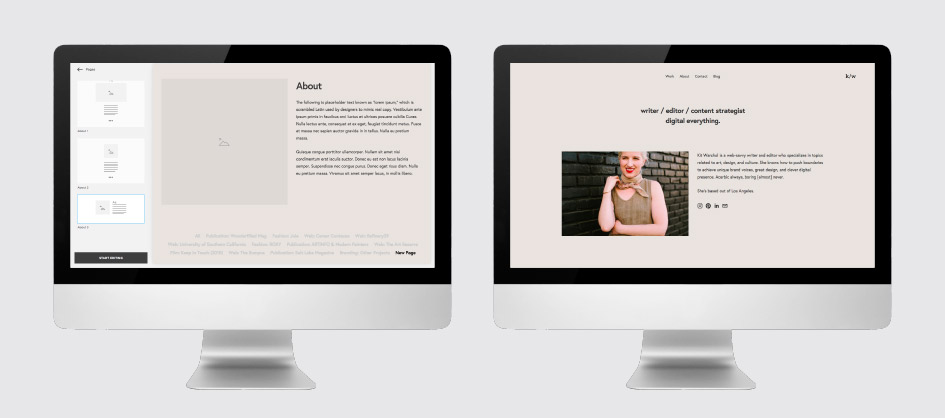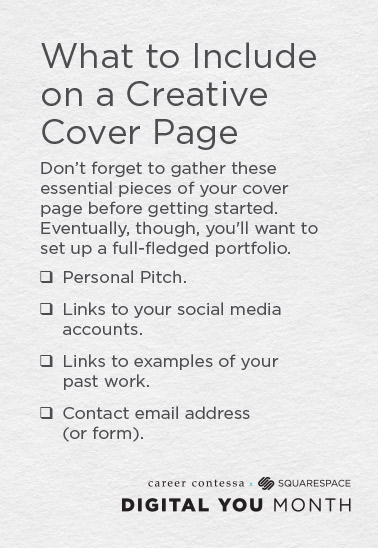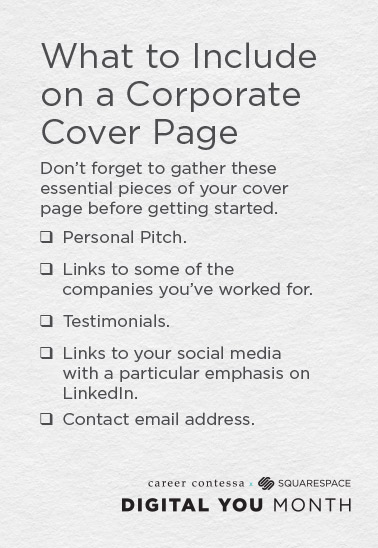Setting up a fully functional personal site requires a lot of planning, gathering, strategizing, photo editing…you get the idea. You’ll get there. But in the meantime, if you don’t have a website, starting small is a great way to get started. The longer your site is up, the more people see it—that math is simple.
OK, REAL TALK: WTF IS A "COVER PAGE?"
 Adding a page and picking a page template (left) / My cover page (right). View the live page here.
Adding a page and picking a page template (left) / My cover page (right). View the live page here.cover pages for the Creative Job Seeker
Is This Me?
- What you do with your hands (or mouse or keyboard) is what you want to do for a living.
- When we say “what do you have in your portfolio?” you can think of clear examples.
- Your goal is to land a job (or promotion or freelance gig) that relies on your creative work.
What to Include:
 Pro Tip: Pin me for later!
Pro Tip: Pin me for later!- Personal Pitch. We’ve got a step-by-step guide for that right here. Creatives are often seeking different forms of employment—some people want the stability of a full-time job, some want to make their own hours by working with clients on contract—so make sure to clarify exactly what sort of work you’re after. If you’re only available for freelance jobs, let ‘em know. If you’re seeking a full-time gig at a company, make sure that’s included in your pitch.
Let them know what you don't want to do, too. If you’ve worked in design and marketing, but you’re so-freaking-tired of doing design work, make that clear as well. This is your space to call out what you want as much as it is a place to play up your experience and skills. (Pro Tip: you can use the same pitch as your LinkedIn summary.) - Links to your social media accounts with a particular emphasis on Instagram, Twitter, Tumblr, or Dribbble (depending on your industry). This is your chance to showcase the way you think and your style, especially if you haven’t had much formal experience in your industry. We know several people who have been hired based on the eye they demonstrated on Instagram or Tumblr alone. BTW, you will still want to include your LinkedIn profile in case any larger companies are considering you for a job.
- Links to examples of your past work. Eventually, you’ll want to set up a full-fledged site complete with a portfolio section that includes detailed summaries of all your past projects, but for your cover page, stick to links. Point people to places where they can read past articles you've written or see a YouTube video of an ad campaign you worked on, whatever you can share that plays up your expertise.
- Contact email address (or form). Make it easy for people to get in touch. You can always set up an info@yoururl.com account if you don’t feel comfortable putting your personal email address on your site. But especially for freelance, you want to make it easy for people to, you know, hire you.
cover pages for the Corporate Job Seeker
Is This Me?
- You’re working in an industry where much of your experience is team-based.
- Maybe your work isn't public, meaning you don't totally feel comfortable sharing your past projects online.
- Maybe you’re a project manager at a marketing firm, maybe you’re in finance, maybe you’re in operations at a non-profit—regardless, your skills are hard to provide visuals for.
What to Include:
 Pro Tip: Puh-puh-puh-puh-pin me.
Pro Tip: Puh-puh-puh-puh-pin me. - Personal Pitch. If you haven't written one, we've got a step-by-step guide for that right here. Corporate job seekers will want to play up the companies they’ve worked for, titles (if they’re glamorous) and results (did you improve profits by 12% in 2015? Do you have a proven track record improving team dynamics as a manager?).
Incidentally, you can use this pitch both on your cover page and as your LinkedIn summary. If you're already happy with your LinkedIn Summary? You just passed Go. Just copy it onto your cover page. - You may want to include links to some of the companies you’ve worked for, especially if they’re in the industry where you’re seeking employment.
- Testimonials. if you feel comfortable, asking a former coworker or employer for a testimonial specific to the skills you’d like to use in your next job is an ideal way to “show not tell” about your work history. Let’s say you want to work in social media—make sure the testimonial includes mention of your past work in that area.
- Links to your social media with a particular emphasis on LinkedIn Make it easy for people to see your presence elsewhere. If you'd prefer to keep your other social channels private, that's totally fine—just make sure they are, in fact, private. And don't forget to update your LinkedIn profile. Doing it at the same time as you build your Squarespace cover page will ultimately save you time.
- Contact email address. Make it easy for people to get in touch.











